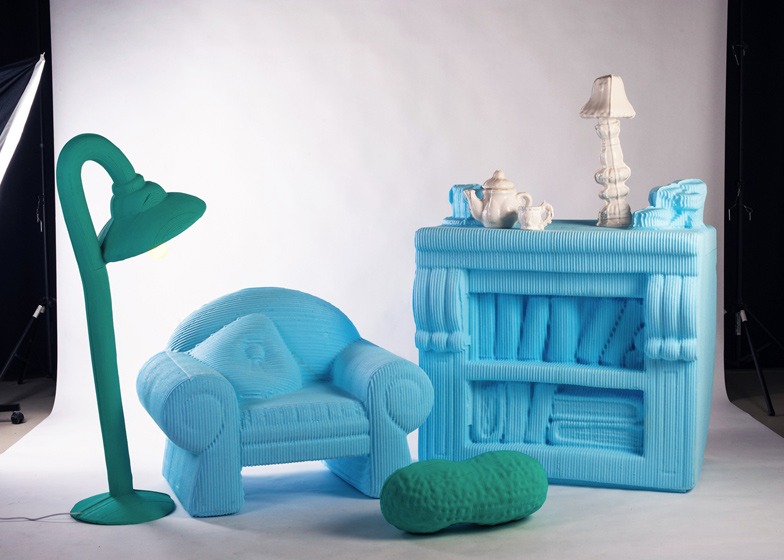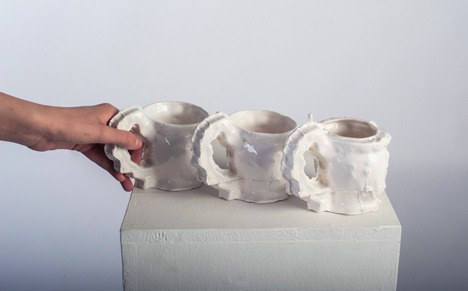Need to Push the Borders Further
Interview with Silvia Lovasova
 Where do you like browsing on the Internet?
Where do you like browsing on the Internet?
I’ll be open with you, I don’t really browse anything apart from design-related sites. But, my boyfriend keeps sending me a lot of links on science and tech gadgets, which is the area that fascinates me. I am also into websites streaming recent TV shows.
So, design-related websites. But there are myriads of them. So which of the crannies lure you?
I follow different individual designers on their websites, but I have a collection of studios, people and websites from the world of design I’m interested in on different social networks. Most often, I go through this mix and I go through all these resources at the same time. My favourite website is currently Disegno Daily, it’s more text-based than various blogs taking over pictures, as it’s a magazine supplement. I also keep track of the websites of Damn and Icon magazines.
Let’s move a bit to the past. Who are your childhood and teenage heroes?
I spent my childhood in a small town surrounded by the commercial culture until the high school when I started dreaming of becoming a famous fashion designer. I’ve never had a specific role-model. I started studying at the Textile department of the High School of Applied Arts and my horizons started to broaden. Back then, my heroes were all the artists that studied at the University of Fine Arts (VŠVU) and I had dreamt of going there during the whole high school. I was taught many both classic and historical techniques and it wasn’t my thing from the very beginning. Also, I found being fixed to one specific material very annoying. So, my final work was about a collection of plastic toys for kids and I decided to study design. I wanted to try new approaches and materials out, although I didn’t actually know what design really was.

At the moment, you belong to the designers who involve new technologies in their work. Why is it so?
After acquiring basic knowledge about basic materials (plaster, clay, epoxide…) that we had to cover at the start of our course, I wanted to try different things available out just like when I was at the high school. At the beginning, it was technology that helped me come to terms with the fact that I am simply not the most skilful and precise person in the world. Moreover, my surroundings perceived these technologies as the tool for simplifying the work as well. We disregarded the fact that they are not only tools, but also a reflection of our times. This gradual coming to know culminated in my diploma thesis that was based on the stance: digital technologies not as a tool, but as a concept – content.
Give us a little more insight into it.
The rationale for the whole collection titled 1:1 was to find such a position, a characteristic trait of digital technologies that is only inherent to them and that wasn’t previously possible. I chose enlarging the miniature version of furniture from a doll’s house because it demonstrates the act which is very simple in the digital world. It’s, however, a demanding operation in the physical world of materials, but nowadays it’s possible thanks to CNC machines. Of course, the choice to enlarge poor-quality imitations of furniture into real-size furniture opened up a new topic, which I am aware of, so at the end of the day, people don’t look at my thesis only from the point of view of a sophisticated use of digital technologies. It is also interesting for me to view this collection as a polemic about the contemporary kitsch, deformed world of kids’ toys or about perfectly performed imperfection.
New technologies today are still in their testing phase. At the same time, they grow old very fast. I sometimes perceive your previous works as some specific artist’s tests. So if you want to use a contemporary language, do you see this problem of a perpetual change? Where is your boundary between the present and the past?
Well, that’s what plays into my hands in order to perpetually experiment and it may help me not to get stuck in one approach. What was true last year may be again different today. But I have never set my mind on the idea that I have to work with the newest technologies. At the moment, they are attractive to me, but I am equally interested in the outcomes that don’t use new technologies at all.

Which unpredictable situations did you meet during this testing?
Maybe that I became aware of the fact that I am fickle. For example, that I am now working more with technologies doesn’t mean that I won’t shortly try something else out. I really don’t like artists selling out. I would like to avoid it. And the second thing is, well maybe not as unpredictable, but I wouldn’t know it without my experience – trying always something new by myself in my studio is time and financially demanding… Always anew. But I learn a lot and I enjoy it.
What I like about your work is that you are thinking (you or together in the Trivjednom group) over the processes or social/behavioural situations in design and not only about the outcome product. For me, it is often more exciting and freer sphere. Why is such complex research so important for you?
In testing, I am really interested in extreme situations in terms of methods and features of the material. For instance, our last work with Trivjednom. It’s a table, quite an ordinary one at a first glance, maybe even a bit fancy. A fine metal frame, minimalist design and a board made of black glossy epoxide. Yet the table is peculiar because of its site-specific design. The table frame is first installed to the ground in the place where it’s supposed to stand, only after then the board is made – liquid epoxide is poured into the frame and it’s special, as it levels out straight all alone. The outcome is a product to which a person who is aware of all these things has a different relationship. The person perceives it as a perfect measure of that place and time. The content in the table is not eye-catching at first, but after a while, I think, it grows upon you even more.
You live in Slovakia, which is not a technological nor a design empire. What do you enjoy here? What are you missing here for your work?
I enjoy being at home and understanding everybody – I mean not just the language, but the context in general. I find it important to understand the environment I live in, although it’s by far not ideal. I am tremendously missing an adequate form of presentations, magazines and of course, clients that would buy me.
At the beginning, I was asking you about your childhood heroes. What I meant was some generational coding, i.e. some common cultural and geographical ground – whose nature is nowadays also quite narrowed down – that’s why that introductory question:) If you had to say something about your generation, what would it be, is there anything that connects you?
I am active as a designer in the multi-generational group Trivjednom, where I am the youngest. My partners in design Sylvia and Ľubica are the closest people when it comes to work. And since we are not of the same generation, I don’t think I can see it in a complex way. But I feel one thing very clearly – speaking of my peers. I have a feeling that our generation of designers emancipate more, we are more enterprising and we have ambitions related to abroad. I guess it applies to almost all the Slovak designers of my age.
Your diploma thesis resonated among many. You’ve had quite successful presentations in the Czech Republic and France. What experience was it for you? And mainly, what feedback on your works did you get? Or, what opinion or commentary caught your attention?
The best experience was definitely the Design Parade contest which takes place every year in French town of Hyéres in the beautiful modernist Villa Noailles. During the week I spent there,
I met many young designers, I was also in touch with the professionals from the jury and this was the place where I got the biggest and encouraging feedback on my work. It surely supported me in my further work and in my effort to present more works abroad. I think that they found my diploma thesis brave and that convinced me that I need to push the borders further and not ease up when they appear.
What else inspires or fascinates you and how is it reflected in your work? What irritates you in design?
I am endlessly fascinated by technologies. Maybe it’s because I don’t quite understand how they work and I have them as little miracles of our world. What I mean is range from exploring the universe to 3D printers. What I see as a link in my work is only that I enjoy trying new things out and every time I finally grasp some new technology and I can use it or even use it innovatively, I feel a great satisfaction. What irritates me about the design scene is when I see a calculated work of independent studios or designers, works that are subject to the preferences of the mainstream audience, so they can be easily sold. Conventionalism and repetition are related to it – when a designer breaks through with one thing and then they keep applying it to all the other objects.
What is your biggest strength?
Determination, I guess. When I set my mind on something, even if there was nobody to help me with production, even if it cost me too much time or lasted a year. I will finally hang that candelabrum somewhere. I am not easily put off by not too good conditions that we face here and I believe it will be simpler with time.
If you could choose, who would you like to cooperate with? Whose design work speaks to you?
There are lots of people on the contemporary design scene whose work speak to me. I could put down a long list. But more than a cooperation with a particular designer, I am more attracted to an option to design an object for production. In limited series, artisanal… just to move from the production in my studio with my own hands towards the production by somebody else based on my design. That is a kind of experience I have seen only partially.